|
I received a call from an animal control contact of mine that was quite disturbing. It still upsets me just thinking about it now. My contact (we'll call her River for purposes of this blog) was trying to help a citizen who had trapped a free roaming cat, also called a community cat. The cat was believed to have an upper respiratory infection. The city does not have an animal shelter. Thinking she was doing the right thing, River took the cat to the local animal hospital with which the city has a contract. She thought the cat would receive veterinary care, would be kept at the animal hospital for the requisite hold period and she would later be able to make the cat available for adoption or get it to a rescue group. What happened next could not be further from what she expected. A vet technician said the cat had to be euthanized and used a heart stick to end the life of the cat while River stood watching in horror. The veterinarian was not on site; the tech behaved like this was common practice. For shame. It is possible the cat may ultimately have been euthanized. Upper respiratory infections in cats are caused by a virus or bacteria and it targets the upper airway instead of the lungs. Having said that, ending the life of the cat by heart sticking without the cat being unconscious is illegal in this state. The vet tech who ended the cat's life this way should be discipline and should lose her job. River reached out to me because she wanted to know about the legality of what happened and because she didn't want it to happen again. Euthanasia can be part of her job for animals who are genuinely suffering or irremediably ill but not like this. We talked about how she could pivot and find different solutions in the future to help cats with the help of local non-profit organizations and the veterinarians with whom those organizations work. We talked about how cats are part of the ecosystem and how it can be impossible to determine just from looking at a cat if he or she is social to people or feral (although there are some behaviors which make it easier to spot a feral cat). It is easy to tell the difference between a domesticated dog and a wild canine. The same cannot be said for cats. At all. River and I talked about Trap - Neuter - Return as the only humane way to manage community cat populations. I have written about TNR before so I won't go into much detail here. The simple explanation is that TNR is a process in which free roaming cats are trapped, sterilized, left-ear tipped for identification (while they are sedated for surgery) and then placed back into the ecosystem in which they were found to stop the breeding cycle and address problem behaviors (mating, marking and yowling). If you want to learn more about TNR, the sources I rely on most are Alley Cat Allies, Million Cat Challenge, Neighborhood Cats (this is specific to New York but has a lot of wonderful information), this 2013 article written by Dr. Kate Hurley and Dr. Julie Levy and this 2019 presentation by Dr. Hurley called Rethinking the Shelter's Role in Community Cat Management. We have been doing TNR at the office where I work for fifteen years with the help of a wonderful organization called Forgotten Felines. It has made a tremendous difference not just for free roaming un-owned cats but for pet cats. We have a feeder station where cats are provided with food and water 365 days a year and near which we do our trapping. Because our close to a housing community, many of our cats come from that community and are social to people. Once those cats are trapped, they are scanned for a microchip, sterilized, vaccinated and made available for adoption. Some of those cats (like Sky, the blue-eyed car you see here) were seriously injured and were able to get the veterinary care they needed because they were attracted to the food source. Those cats who are not social to people are put back into the ecosystem where they are monitored for body weight and general health. When we see an ear-tipped cat, we know it is part of our small colony. There have been a few cats over the years who were so ill they had to be euthanized. We had a old tomcat we tried to help recently who had an infection that was just too advanced to be saved. As sad as it was that he was euthanized, he knew comfort in the last weeks of his life and he avoided what would have been a prolonged and very painful death. River and I also talked about a newer concept called Shelter - Neuter - Return, a subject about which I have engaged with the experts at UC Davis in California. This is similar to TNR but relates to cats entering shelters and how we best help them. Amanda Newkirk shared the following information with me a few years ago: The vast majority of communities have far more cats living outside than adopters looking to bring them inside. For years we trapped cats, brought them into the shelter, tried to adopt as many as we could and, sadly, euthanized the ones that weren’t so lucky. That is until we found out there are an estimated 60-80 million cats living outside and this strategy for managing cats was not one that was ever going to be successful. In fact, removing a small percentage of cats from an environment has actually been shown to increase the number of animals born during the next birthing cycle. I am contacted often by people who oppose TNR or who just don't understand how it works. Most of the opposition is from people who believe the cats they see outside are suffering or who treat cats as an invasive species that pray on birds and other wildlife and would rather have the cats destroyed. People a lot smarter than me have done extensive studies on this topic and I remain unconvinced that the opposing arguments have merit. Removing cats from areas where they are found creates something called the vacuum effect in which other cats take their place. Large-scale efforts to eradicate cats like have been attempted in other countries have never worked and have often endangered other species. I invite anyone who opposes TNR to educate themselves on the facts and not based on sensationalized media hype or emotional arguments. A good place to start is here. On to how it works. It should be obvious: when cats are sterilized, they no longer produce offspring. But the benefits of TNR go way beyond that because of how the presence of those cats in the environment affect other cats around them. My communication with River led to to revisit Dr. Hurley's presentation from 2019 to refresh on what I had learned years ago. It was time well spent. I encourage everyone who is interested in the well-being of all cats to watch the full presentation. This excerpt gets to the heart of why TNR works and last about 4 1/2 minutes. I was very pleased to see a recent Facebook post from another wonderful organization in our area that focuses on TNR and helping people get their pet cats sterilized. They helped River recently with a feral male cat so she could find her pivot. She did not take the cat to the animal hospital where his life likely would have been ended, perhaps in an unspeakable way. River trapped the cat and took him to a veterinarian who agreed to help. This veterinarian sterilized, vaccinated and ear-tipped the cat with the expenses paid by the local nonprofit. The cat was released back into his habitat to live out the rest of his days. He had healthy body weight and it is possible he will live for many more years and will no longer be the "rolling stone papa" he once was. My personal hope is that this new relationship between River and the nonprofit organization means community cats will get the help the need in a way that is humane and which also helps the community.
Thank you for your compassion, River. Thank you for taking a terrible situation and using it to find a humane solution for the future.
0 Comments
 The subject of whether or not companion animals go to Heaven is a controversial one. After we let Snake go in 2006, I did a lot of reading on the topic including a wonderful book by M. Jean Holmes called, "Do Dogs Go to Heaven? Eternal Answers for Animal Lovers." It helped. There was a big hullabaloo in the media a couple of years ago after Pope Francis made some comments about dogs going to Heaven which were initially mistranslated and later clarified. Regardless of what Pope Francis really said or how you interpret it personally, most of us have our own opinions about whether or not animals have souls. (And pretty much every animal lover on the planet got a kick out of a meet and greet Pope Francis had with some service dogs last year which led to some memorable images in which a dog "photo bombed" the Pope.) There is a new movie coming out called "A Dog's Purpose" which is based on the W. Bruce Cameron book by the same name which tells the story of a dog which is reincarnated many times and "who finds the meaning of his own existence through the lives of the humans he teaches to laugh and love." I have my own beliefs regarding companion animals which have been forged through time, experience and loss. Whether you agree with me or not is of little consequence. I believe our companion animals do have souls. I believe that when they leave this Earthly place, they move on to another existence, as do people. I believe that some animals come into our lives to teach us lessons and to help us learn how to be better versions of ourselves. They are part of our becoming. I also believe that some of us are animal guardians or paladins and that there are times when animals are put in our path (or we develop some awareness of them) so we can either personally help them get where they are meant to be or to facilitate that process in some way. 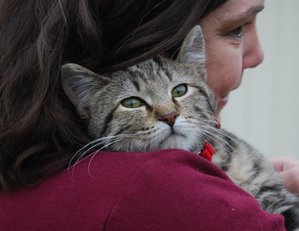 So, that is an animal guardian? In my view, these are people who are focused enough on animals to know when they need help, are willing to help those animals in need and who believe that they are used as instruments as part of a bigger plan to help certain animals. If you view yourself as an animal guardian, you may be nodding by now, thinking back to all of the times that an animal crossed your path or entered your life inexplicably, not to become a member of your family, but so that you could be used as an instrument to help that animal. Most people in animal rescue are eternal guardians and may feel like animal magnets. Something that happened to a friend recently served to reinforce my belief about her status as an animal guardian and I thought it worth sharing her story. Shelley was staying at a the Harrah’s in Reno for the holidays over the Christmas Eve/Christmas Day weekend. She and her family had taken the train to Reno with her mom for a holiday trip in 2015 and they decided to go for a memorial trip in 2016 after her mom passed away. It was a way to honor her mom and get through that first holiday season without her. It was cold. Seventeen degrees to be exact. Shelley and her family were coming back from dinner on Christmas Eve when they saw a young cat run around the long entry to the hotel, crying. The cat was obviously trying to get someone’s attention. Shelley and some others did their best to get the cat, feeding it chicken at one point to distract it. They had no luck at all. Shelley stayed up most of the night revisiting the entrance trying to get the cat but with all of the foot traffic, it was impossible. When she got up at 4:00 on Christmas morning, the cat was nowhere to be found. They were scheduled to leave Reno at 8:00 a.m. Shelley called a local rescue group and left a voice mail to explain the situation and to ask them for help, only to get a text later that day saying there was nothing they could do and to contact animal control. Shelly was despondent, later telling me, "you know what it’s like, one of those situations that you cannot help, and that will haunt you forever." But all was not lost. Shelley told me about her "Harrah’s kitty." Reno? I have contacts there. I checked in with Diane Blankenburg of Humane Network whom I know from my no kill advocacy. Diane was the Community Programs and Development Director of Nevada Humane Society in Reno for years up until 2013. I was sure there was something which could be done. I asked Diane if there wasn’t some way that the NHS could help refer Shelley to a local organization which does TNR (trap, neuter, return) in the city. (Much like other "entertainment" cities like Las Vegas, Reno has a large population of free roaming cats who live in certain areas due to the resources they find there.) Diane said she was sure NHS still had a TNR program. She connected with Denise Stevens, the Chief Operating Officer at NHS to explain about the cat. Denise was gracious enough to contact Harrah’s security staff about the cat and was told that the talkative little cat had been taken to Washoe County Animal Services (which shares a building with NHS). The Harrah’s cat was safe. He was transferred to NHS from animal control and was temporarily named "Feral Tune" due to his propensity to talk. We’re waiting on an update now about his condition. Looking at what happened over a period of days, the outcome was surely improbable. What are the odds that a single cat seen at a very busy hotel in a very busy city would be helped over a holiday weekend? Surely lots of other people saw and heard the cat. Shelley was worried for days, not knowing the outcome and fearing the worst. She felt responsible in some way. But she also underestimated her role as an animal guardian. This is not the first time an animal in need found Shelley and it won’t be the last. I have no doubt that Shelley saw Feral Tune so she would seek help and set a series of events in motion which would ultimately confirm the lost cat was safe. California + Nevada + Alabama = a saved cat. As it was surely meant to be. NOTE: If you think you are an animal guardian, I cannot encourage you strongly enough to educate yourself about some basic issues regarding companion animals and to connect with local animal shelters and rescue groups so that you have a plan in place in the event that an animal in need finds you. Be prepared for your next guardian encounter and be prepared to see the situation through to the point where the animal is placed in a new home or with a reputable organization. In short, be prepared to "own" your guardian status. It is not enough to by sympathetic to animals in need; you have to be prepared to actually help them in a direct and meaningful way to the extent you can. Please also do not assume that any animal you help is unwanted or was abandoned. Pets go missing very day for a host of reasons and not all of them relate to someone's irresponsibility. If you find a lost animal, report that fact to your local animal control personnel and list the pet on Helping Lost Pets. Every municipality has a "property hold period" so people can reclaim a lost pet. The best outcome for most lost pets is simply to get back home where they belong with people who care about them. (image of Tashi courtesy of Becky Lynn Tegze; image of Feral Tune courtesy of the Nevada Humane Society)
I have finished reworking my slide show about community cats and TNR in advance of National Feral Cat Day which is on Sunday, October 16th. My prior version from 2011 lacked some of the current terms of art we now use and it needed an upgrade. Thanks to Fisher for the music use. Thanks to Lisa, Chriss and others for the video clips and images. As I blogged about recently, my experiences with TNR (trap, neuter, return) are both personal from the colony I help manage and as a result of friends and contacts across the country who do TNR and have for years. Whenever I hear someone speaking out against TNR, I wonder if they actually care about cats. I’m confident from what I’ve read and from the research by Alley Cat Allies that TNR truly is the most humane method to reduce cat populations. And I am reminded of the cats we have helped as a result of TNR who may have suffered and died without our help, many of whom were social to people and were just lost or injured. Chloe, Abby, Romey, Dot, Ford, Locke, Hollis, Channing, Holton, Wynn, Larry, Sky.
A friend of mine in California who does TNR recently helped a male cat she named T.C. It took weeks to trap him and he was put into a foster home. It was later determined that T.C. was very sick and he ultimately could not survive his ailments. His foster mom, Nan, wrote this note about his passing and I hope you will take a minute to read it. And then you will think twice when someone says that free roaming cats should just be destroyed. If your cat was lost or went missing, you would want someone doing TNR to help him or her: It is with a heavy heart, deep sorrow, and much sadness, I bring the news that T.C. lost the fight for his life today - he passed away this morning in my arms. Though he was a fighter, "my trooper", after being neglected for so long, it was just too much for his frail body. I'm glad I was able to be here for him. I am going to miss his little smiling face, looking at me upside-down, as I would rub his full belly. Not many male cats will let you rub their belly without shredding your arm, he definitely was not a feral cat. My condolence lies in the fact that T.C. got to know what it felt like to have a full belly every day, along with a warm comfortable bed to sleep in without worrying about anything, and having someone doting on him, giving him all the love and affection he wanted. Getting to know him was priceless. Godspeed, T.C. I'm sorry you couldn't stay. But I'm thankful you were helped and loved and you received the best possible care in your last days. 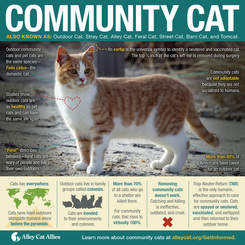 click image to view .pdf click image to view .pdf National Feral Cat Day is on Sunday, October 16, 2016. As we approach this national day of awareness and education, I wanted to blog about the topic of community cats. I know I tend to talk about dogs more than cats on my website simply due to my volunteer work for certain nonprofit organizations which help dogs, but the issue of community cats is one I deal with on a regular basis because of the managed colony of community cats where I work. What is a Community Cat? A community cat is a cat who lives outside. These cats are also known of as outdoor cats, stray cats, alley cats, feral cats, street cats, barn cats and tomcats. They originate from former domestic cats who were lost or abandoned and then learned to live outdoors or in environments involving little human contact, such as warehouses, factories or abandoned buildings. Outdoor cats live in family groups called colonies. They are bonded to their environments due to the resources they find there: food, water and shelter. They are also bonded to each other for companionship and protection. What is a Feral Cat? A feral cat is a community cat but not all community cats are feral. A feral cat is one who is not socialized to humans. You can often tell the difference between feral cat and a cat who is social to humans through body language and behavior. A stray cat which may be social to people will often approach people, houses, porches and cars. A feral cat will not approach people and will seek out places to hide. A stray cat might walk or move much like a house cat with his or her tail in the air. A feral cat may crawl, crouch or stay low to the ground and protect his or her body with the tail. A stray cat may look at you, blink, make eye contact or even vocalize near you. A feral cat is unlikely to make eye contact or vocalize at all. 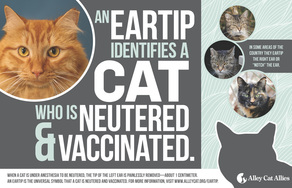 click image to view .pdf click image to view .pdf Shouldn’t We Just Destroy These Cats? Some people would argue that community cats should be destroyed in order to remove them from the ecosystem or to prevent them from destroying birds. Free-roaming cats live in certain areas because of the resources available there. If you destroy the cats, more will simply take their place. This is called “the vacuum effect.” The arguments that feral cats destroy wildlife or spread rabies are myths. Habitat destruction and pesticides are the main cause of diminishing wildlife. According to Alley Cat Allies, the last confirmed cat to human transmission of rabies occurred more than 40 years ago. Outdoor cats are as healthy and pet cats and can have the same life span. In stark contrast, more than 70% of cats who end up in shelters nationally are destroyed. When it comes to community cats, that number rises to 100% in all but the most progressive communities. A national survey conducted by Alley Cat Allies showed that more than 80% of Americans believe that leaving a stray cat outside to live out his or her life is more humane than having the cat caught and killed. More than 40% of Americans have cared for an outdoor cat; it is clear that Americans want compassionate approaches for cats. How Do We Help These Cats? Studies have shown that Trap-Neuter-Return - TNR - is the only method proven to be humane and effective at controlling community cat population growth. Using this technique, all the cats in a colony are trapped, neutered (or spayed), vaccinated and then returned to their territory where caretakers provide them with regular food and shelter. It is customary to “ear tip” the left ear of the cat during surgery so the cat be easily identified as a cat who has been sterilized and vaccinated. Young kittens and friendly adults trapped in TNR are placed in foster care and eventually adopted out to good homes. TNR stabilizes the size of the colony by eliminating new litters. The nuisance behavior often associated with feral cats is also dramatically reduced, including the yowling and fighting that come with mating activity and the odor of un-neutered males spraying to mark their territory. What Are Some of the Indirect Benefits of TNR? In addition to helping cats who live outside, another significant advantage to TNR is that it lessens the number of kittens and cats flowing into local shelters. It is more humane and cost-effective to use TNR to control cat populations so that tax-dollars are not needlessly spent on what is sometimes referred to as a "catch and kill" method of handling free-roaming cats. Another indirect benefit of TNR is what cats who are social to humans, but who are just lost, scared or injured, are helped in the process. A cat who is outside and who needs help is often hard to distinguish from a feral cat. It is only in the process of doing TNR that rescuers and people who help cat colonies are able to help cats who require veterinary care or who are completely social to humans and just need a new home. Why Would Anyone Oppose TNR? The topic of feral cats is one which is the subject of a lot of controversy nationally. In spite of numerous studies to the contrary, there are those who are simply convinced that free roaming cats are a danger to wildlife, they harm the environment and they should just be destroyed. I simply could not agree more. I will leave it up to organizations like Alley Cat Allies to fend off the blows of the cat haters with science. For me, this is just a simple issue: TNR works. 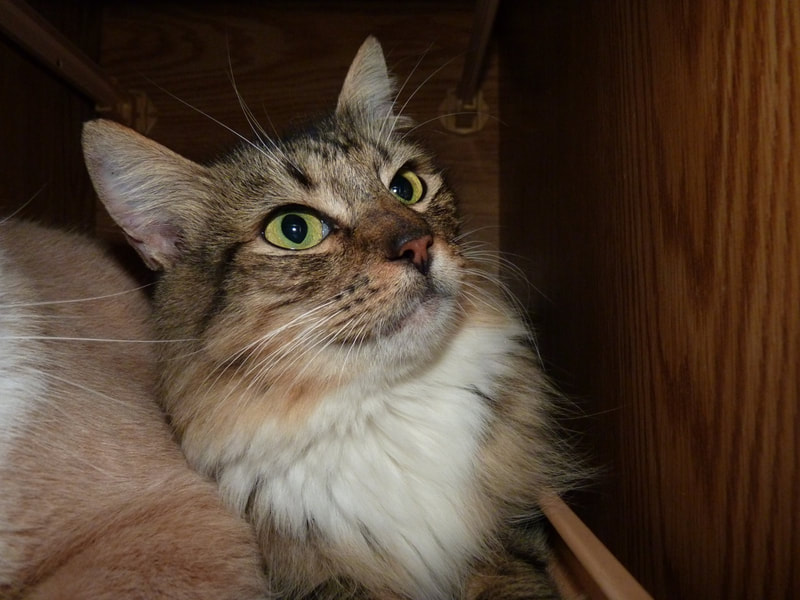 My Personal TNR Story. I work at an office building in a centrally located area of a fairly large city, next to the major thoroughfare which runs through the city from north to south. We have been doing TNR of community cats for years with the help of a local rescue group called Forgotten Felines. I know for a fact that in the years we have been doing TNR, 90% of the cats we have helped were actually social to people and were not feral at all. Many of them acted unsocial at first, but once they were trapped and helped, we found that they actually seemed relieved to be safe and in the company of people. Yes, some of our cats really are feral and they live outside in our managed colony, moving between parcels primarily through the street drainage system. They are fed once a day 365 days a year, we monitor their health by observing them and I dare to say they have it pretty good between nutritious food and some cat houses which are actually insulated with spray foam. For those who oppose TNR, saying it is cruel or not effective, I say this: if you really care about the welfare of cats, you simply cannot discount the fact that TNR reduces cat populations, keeps kittens from being born and helps pet cats who are social to people. We have helped cats who were so thin they were on death’s doorstep. We had one cat with multiple broken bones in her front left arm that had to be treated by an orthopedic surgeon. Still other cats have had infections which gone untreated may have killed them. But for us doing TNR and helping the cats who make their way to one of our feeding stations, they would have died and in many cases their death would be slow and painful. And but for us doing TNR and helping cats here, they would likely have ended up in our municipal animal shelter where they would have been destroyed using tax dollars. If your cat was lost or went missing, you would want someone doing TNR to help him or her. I cover a number of subjects on my web site: puppy mills, breed bans, aggression in dogs, chaining, spay and neuter. I chose each of the topics on the site because they are all related in some way to the subject of what takes place in our animal shelters using our money. If you are not currently aware of what is taking place in a "shelter" near you in your name and using your tax dollars, I am here to burst the bubble of your ignorance, I'm afraid. Unless you live in what is called a no kill community (a place where tax dollars are not used to destroy healthy and treatable animals), your shelter is likely destroying the vast majority of animals and is blaming you for being "forced" to do so. Animals enter the building, some are adopted out and the rest are destroyed, having been given no individual consideration at all. I cover each of the subjects I have on my website because they all related to shelter killing in some way. Puppy mills lead to deaths of dogs in shelters because mills produce countless dogs each year (due to our demand), infusing more dogs into the system than we need. Failure to use a process called Trap-Neuter-Return to reduce populations of free roaming (or "community" cats) causes many of them to be trapped and taken to our shelters where most are summarily destroyed (when they do not belong in our shelters any more than does a squirrel.) When we don't spay and neuter our pets, we create population problems in our communities and animals which should not have been born in the first place end up in the shelter system. Because shelters kill animals, many people believe those animals are somehow damaged and so they choose to get pets from other sources like the internet, the newspaper or even worse, a Walmart parking lot. I could go on, but you probably get the point. I am incredibly harsh in my criticism of the animal sheltering system in America. I'm pretty much zero tolerance on this subject because I know there are proven programs which are being used across the country to save animals which end up in our shelters. There is just no good reason for them to die. I think it is entirely hypocritical to call ourselves an animal-friendly country while we destroy savable dogs and cats behind closed doors. It is our public shame. And it is up to us to stop it. We do so by making better personal choices but also by speaking up to demand that our money be used not to end lives but to save them. Do you know what's happening at your local animal shelter? Ask. Do you know how your choices affect what takes place in your community? Think about it. image courtesy of Peace and Paws Rescue
|
AuthorI am an animal welfare advocate. My goal is to help people understand some basic issues related to companion animals in America. Awareness leads to education leads to action leads to change. Archives
July 2024
Categories
All
image courtesy of Terrah Johnson
|




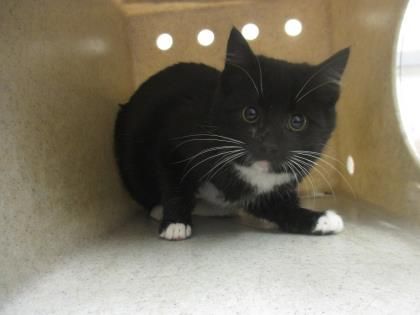
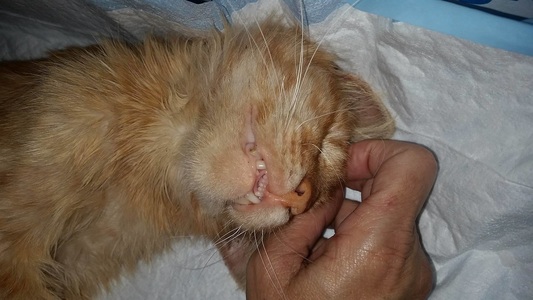
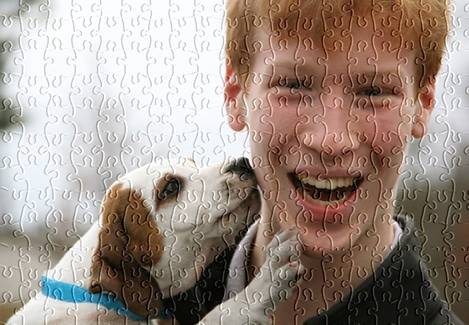
 RSS Feed
RSS Feed